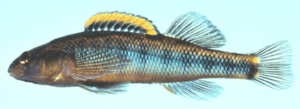Roanoke darter facts for kids
Quick facts for kids Roanoke darter |
|
|---|---|
 |
|
| Conservation status | |
| Scientific classification | |
| Synonyms | |
|
Etheostoma roanoka Jordan & Jenkins, 1889 |
The Percina roanoka, also known as the Roanoke darter, is a type of ray-finned fish that lives in freshwater. It belongs to a group of fish called darters, which are part of the Percidae family. This family also includes perches and pikeperches.
This fish is found in the United States, specifically in Virginia, West Virginia, and North Carolina. It lives in river systems like the Roanoke, Tar, and Neuse. The Roanoke darter is known for its bright colors and is usually about 4.3 centimeters (1.7 inches) long. It eats small insects and other tiny creatures. This fish is quite common, and experts say it is not in danger of disappearing.
Contents
What Does the Roanoke Darter Look Like?
Male Roanoke darters, especially when they are ready to breed, have black heads and red or orange jaws. Their back fins are black with orange stripes. Their other fins are white with clear parts. The sides of their bodies can be dark brown to black, with hints of blue, yellow, or green.
Female darters and males that are not breeding look similar, but their colors are not as bright. This fish usually has between nine and twelve spines on its back fin. It also has seven to nine anal fins and nine to twelve rays on its back fin.
The average length of a Roanoke darter is about 4.3 centimeters (1.7 inches). However, some have been found to be as long as 7.8 centimeters (3.1 inches). These fish usually live for about three years.
Where Does the Roanoke Darter Live?
The Roanoke darter lives in the areas where water flows into the Roanoke, Tar, and Neuse rivers. These areas are in Virginia and North Carolina. You can also find them in the northern parts of the James River in Virginia. They are also present in the New River in both West Virginia and Virginia.
This darter prefers to live in rivers that are small to medium in size. Adult and young Roanoke darters like to stay in streams where the water flows quickly over rocks, called riffles. They prefer areas with a gravelly river bottom. Very young darters often live in calmer pools of water located near these riffles.
How Does the Roanoke Darter Behave?
Reproduction and Life Cycle
The Roanoke darter lays its eggs, a process called spawning, from late May to late June. In the New River, scientists have seen Roanoke darters reproduce with another type of fish, the sharpnose darter. When they do this, they create hybrids, which are offspring that are a mix of both species.
What Does It Eat?
The Roanoke darter is a carnivore, meaning it eats other animals. Its main food sources are small insect larvae, such as those from midges, mayflies, and black flies.
Is the Roanoke Darter in Danger?
The International Union for the Conservation of Nature (IUCN) has looked at the Roanoke darter's situation. They have classified it as a "least concern" species. This means that the fish is not currently in danger of becoming extinct.
There are several reasons for this good ranking. The Roanoke darter lives in a very large area, and its population size is stable. There are also many groups of these fish living in different places. Plus, there are no big threats that could harm its survival right now.
See also
 In Spanish: Percina roanoka para niños
In Spanish: Percina roanoka para niños


